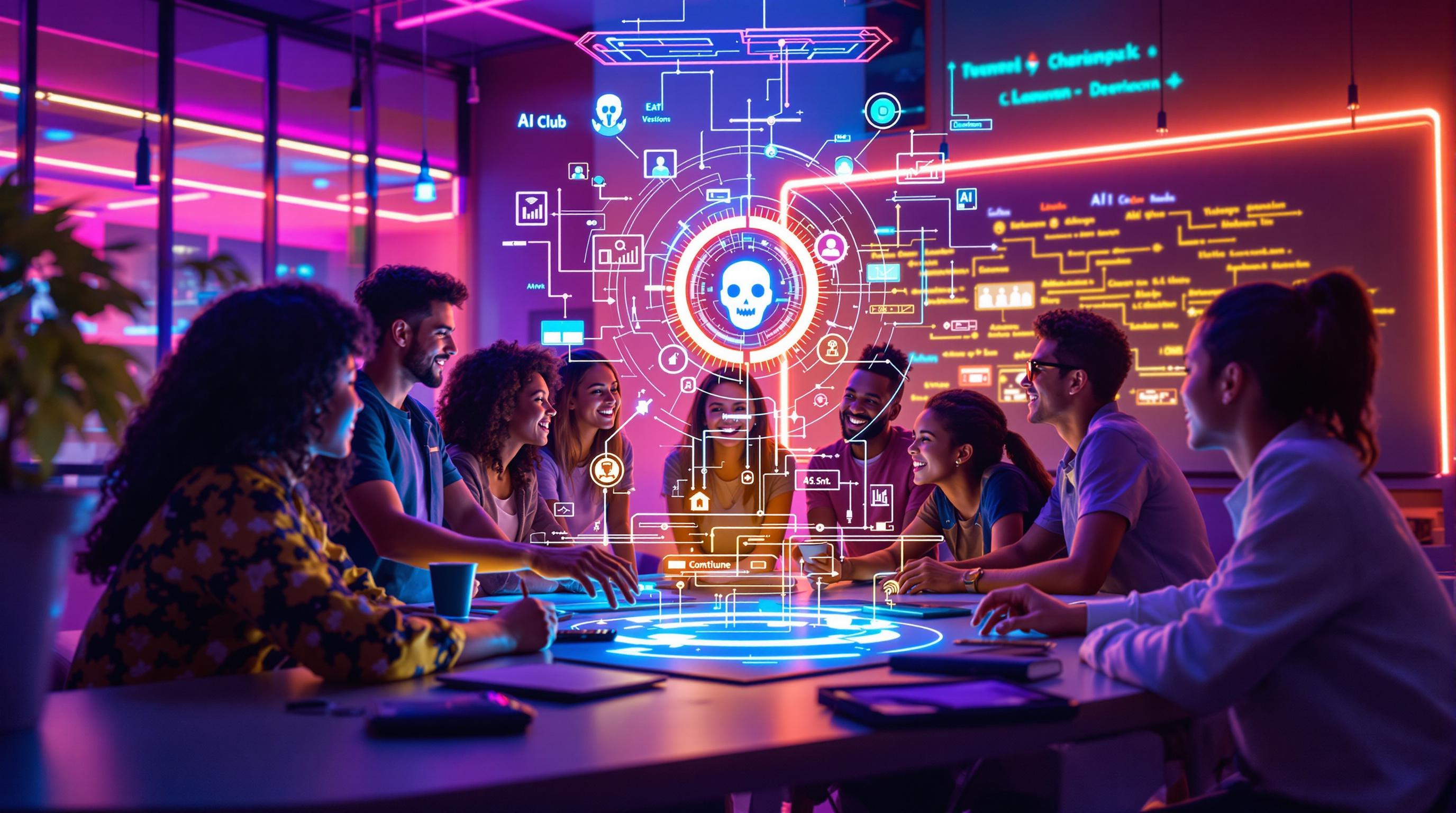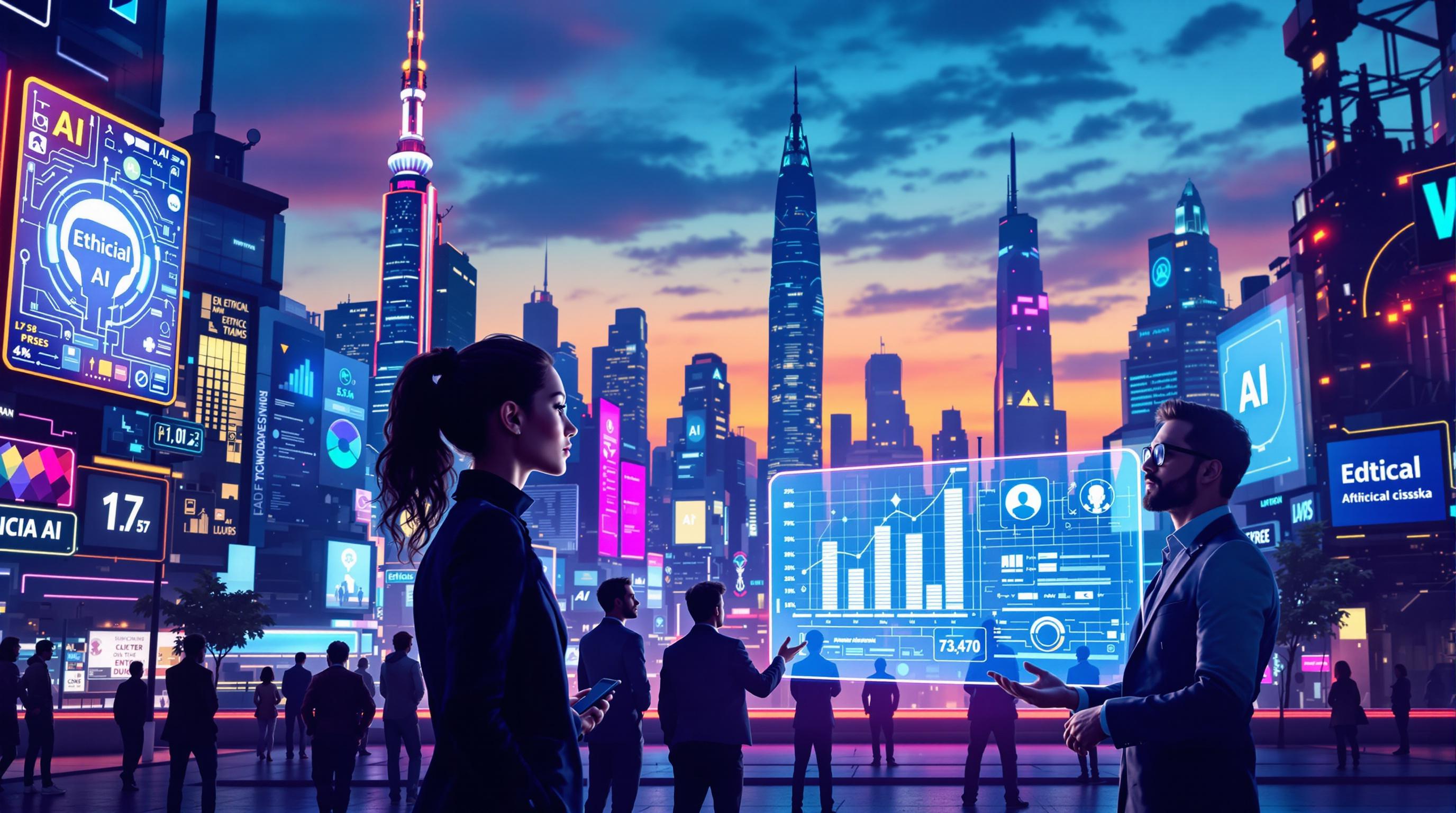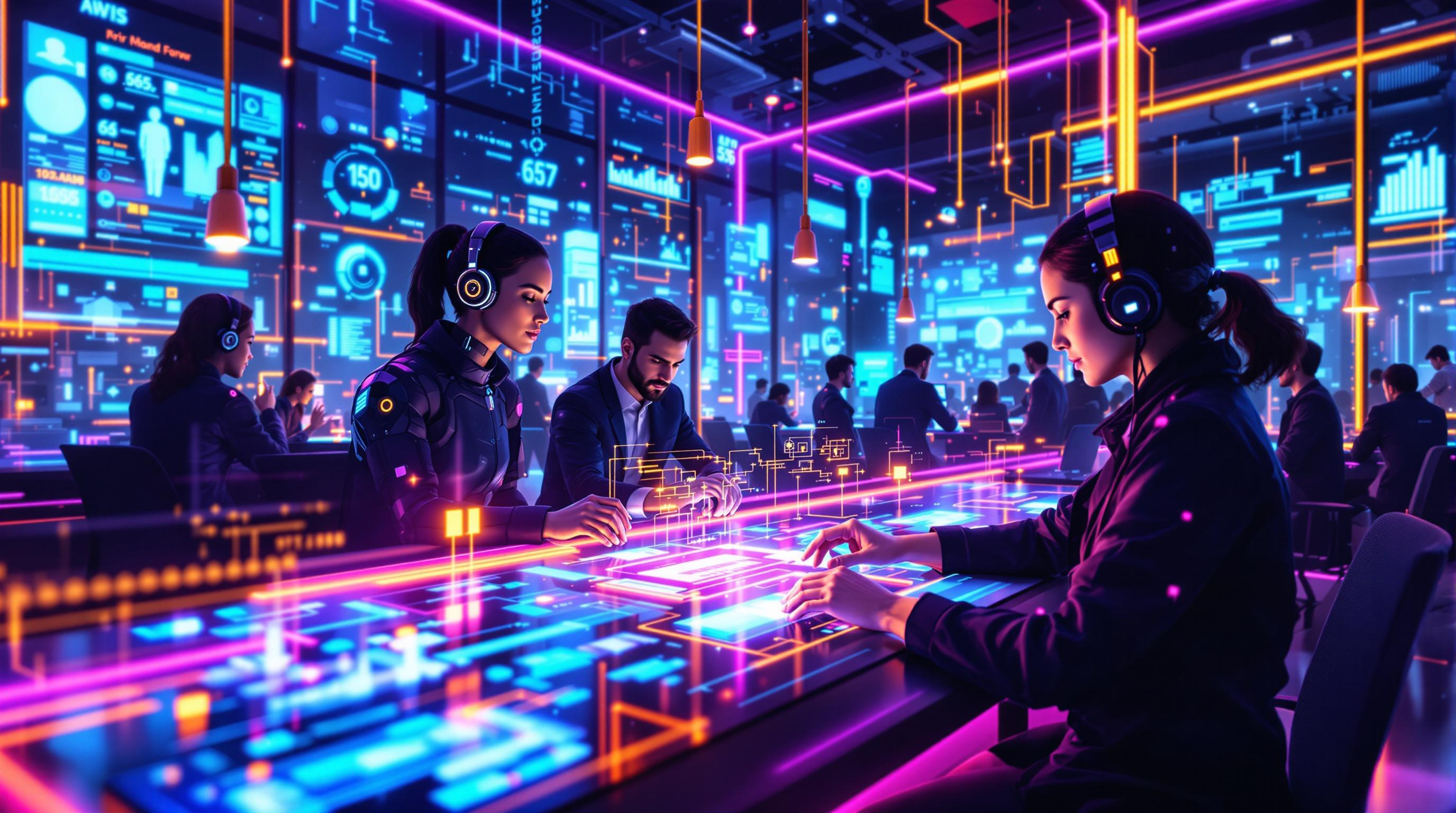- Automated Video Processing: AI automates tedious tasks like rotoscoping, scene analysis, and color grading, saving time and effort.
- Deepfake Technology: Enables hyper-realistic facial transformations, faster workflows, and seamless character animations.
- Real-Time Rendering: Instant visualization and faster adjustments with AI-powered tools, reducing rendering times significantly.
- Generative AI: Automates asset creation, texture generation, and character animation, freeing up artists for creative tasks.
- Motion Tracking and Analysis: AI improves precision and speed in tracking motion patterns, blending CGI with live-action seamlessly.
- Cloud-Based Editing: Enhances collaboration with remote teams, integrates AI tools, and boosts workflow efficiency.
- Hyper-Realistic Effects: AI-driven simulations for water, fire, and crowd dynamics create lifelike visuals while optimizing production.
Quick Comparison:
| Trend | Key Benefit | Example Tools/Studios |
|---|---|---|
| Automated Video Processing | Saves time on repetitive tasks | REVIZE, Crafty Apes |
| Deepfake Technology | Realistic facial transformations | REVIZE, Marvel Studios |
| Real-Time Rendering | Instant adjustments and previews | Rising Sun Pictures |
| Generative AI | Automates asset creation | DALL-E, Midjourney |
| Motion Tracking | Precise motion detection | Used in Furiosa |
| Cloud-Based Editing | Remote collaboration | Autodesk Cloud |
| Hyper-Realistic Effects | Lifelike CGI and simulations | Avatar: The Way of Water |
AI is not replacing artists but enhancing their creativity. These advancements are redefining VFX workflows and pushing the boundaries of visual storytelling.
Create AI VFX Visual Effects With Runway Gen-3

1. Automated Video Processing
AI is shaking up VFX workflows in 2024, with tools like REVIZE making processes faster and more efficient without losing the creative touch [2]. Some of the standout advancements include rotoscoping, scene analysis, and improving visual quality.
Rotoscoping and Tracking: AI now takes over the tedious task of frame-by-frame rotoscoping and object tracking, significantly cutting down on time and effort [3].
Smart Scene Analysis: Advanced AI tools can analyze motion patterns and automatically create photorealistic CG environments. This not only opens up new creative opportunities but also speeds up production [5].
Improving Visual Quality: AI tools handle tasks like color grading, noise reduction, frame interpolation, and upscaling, ensuring polished results with less manual labor.
Studios like Crafty Apes have already adopted these AI-driven tools, allowing them to meet tight deadlines without sacrificing quality [2]. Automation has redefined how VFX teams work, enabling quicker iterations and immediate feedback - an essential advantage for fast-paced projects [1][3].
However, AI isn't about replacing artists - it’s about enhancing their work. Human oversight remains critical to ensure that the technology supports, rather than overshadows, artistic vision [2][3]. These advancements are setting the stage for even more exciting developments, including real-time rendering and generative AI.
As workflows become more streamlined, the horizon is expanding toward AI-powered tools that can create entirely new visual experiences, like deepfake technology.
2. Advances in Deepfake Technology
Deepfake technology has made huge strides in 2024, reshaping how visual effects teams handle facial transformations and character animations. Rising Sun Pictures has been at the forefront, using their machine learning toolkit REVIZE to integrate AI-powered deepfake tools into their workflows [2].
Hyper-Realistic Transformations: With this technology, creating facial transformations that are almost impossible to distinguish from real life is now achievable. It offers precise facial tracking and manipulation, making CGI and live-action blends seamless [3]. Productions like the Marvel Cinematic Universe and Game of Thrones have benefited greatly, especially for character transformations and digital doubles [2].
Faster and More Efficient Workflows: Deepfake tools are changing the game for VFX teams. By automating complex tasks like facial tracking, the technology frees up artists to focus on creative decisions. This automation slashes production timelines without compromising on quality [2].
How It Impacts Studio Workflows: The integration of deepfake tools has brought measurable improvements to the VFX process:
| Aspect | Traditional Method | AI-Powered Deepfake |
|---|---|---|
| Processing Time | Weeks | Hours |
| Manual Labor | Extensive | Automated |
| Costs | High labor costs | Lower expenses |
| Quality Control | Time-consuming | Faster iterations |
Creative Uses and Challenges: Studios are using deepfakes for tasks like creating digital doubles, altering character ages, and seamless transitions. However, the results rely on having high-quality source material [4]. When combined with real-time rendering, these tools allow for instant character transformations, opening up new storytelling possibilities.
As deepfake tools continue to improve, their integration with real-time rendering is set to change how VFX teams handle complex animations. This blend of AI technologies hints at even more breakthroughs in visual effects.
3. Real-Time Rendering Tools
Real-time rendering, powered by AI, has reshaped how VFX workflows function in 2024, allowing instant visualization and faster creative experimentation.
Industry Applications
Top VFX studios are now using AI-driven real-time rendering to push creative boundaries. This technology allows for immediate adjustments while still delivering high-quality visuals [3].
Performance Improvements
AI-optimized rendering has completely changed the game for production teams. Here's how it compares to traditional methods:
| Aspect | Traditional Rendering | Real-Time AI Rendering |
|---|---|---|
| Rendering Time | Hours to Days | Instant |
| Iteration Speed | Slow | Immediate |
| Cost Efficiency | High Computing Costs | 90% Time Reduction [1] |
AI-Powered Features and Workflow Impact
Studios like Rising Sun Pictures and Crafty Apes are using AI tools that identify and fix problems like lighting mismatches, texture issues, and animation errors as they happen [2]. These automated corrections free up artists to focus on creativity instead of troubleshooting, speeding up production timelines significantly.
Cloud-Based Collaboration
By combining real-time rendering with cloud technology, global teams can now work together seamlessly. Artists can make instant changes to visual effects from anywhere in the world [1]. This setup has streamlined production pipelines, making it easier for studios to handle more projects and experiment with complex effects.
As these tools grow more advanced, they open up possibilities like using generative AI to create entirely new visual content. The future of VFX is looking faster and more collaborative than ever.
4. Generative AI for Visual Content
Generative AI is reshaping how visual effects (VFX) studios create and manipulate digital assets in 2024. It automates the production of intricate visual elements while giving artists more room to focus on their creative vision.
Current Applications
Leading VFX studios are using generative AI to transform asset creation workflows. Tasks like texture creation, character animation, and asset generation are now automated, cutting production time drastically - from days to just hours - all while delivering top-tier quality [3].
Advanced Features
Tools such as DALL-E and Midjourney are making it possible to craft one-of-a-kind visuals and refined assets. This was showcased in Lux Aeterna's experimental sci-fi film Reno [6].
"We're right at the start of an age of generative AI systems and synthetic media", says James Pollock, Creative Technologist at Lux Aeterna.
Workflow Integration
Generative AI simplifies processes like rotoscoping, removing wires and rigs, and generating textures. This allows artists to spend less time on technical tasks and more on creative decision-making [3]. By blending AI automation with human input, these tools enhance workflows without compromising artistic integrity.
Industry Impact
Rather than replacing creativity, generative AI acts as a support system, helping artists focus on big-picture ideas while it handles tedious, time-intensive tasks [3]. Beyond improving efficiency, it opens up new creative opportunities in visual storytelling.
As the technology continues to advance, its combination with motion tracking is set to push the boundaries of what’s possible in visual effects.
sbb-itb-f88cb20
5. Motion Tracking and Analysis
AI-driven motion tracking is transforming visual effects workflows in 2024 by automating motion detection and tracking, making processes faster and more accurate.
Advanced Tracking Systems
Modern AI tracking tools are essential for high-budget productions like Furiosa: A Mad Max Saga [2]. These systems automatically analyze motion patterns in real time, allowing visual effects to blend seamlessly with live-action footage.
Expanded Applications
Building on AI's role in automated rotoscoping (discussed in Section 1), motion tracking tools take precision to the next level. They excel at tasks like separating elements in footage and efficiently handling wire and rig removal, cutting down on manual work and saving time [3]. AI algorithms also analyze motion to ensure effects are placed in ways that maintain visual consistency [1].
Industry Usage
Studios like Crafty Apes are using these tools in projects for the Marvel Cinematic Universe [2]. These systems are particularly effective in simulating complex scenarios, such as fluid dynamics or large crowd movements [3].
"AI is reshaping how visual effects are conceived, created, and integrated into film and television productions." - Synapse Studio [3]
Integration Challenges and Benefits
While AI motion tracking boosts accuracy and speeds up production, it also demands staff training and powerful processing setups. The technology shines in areas like 360-degree video editing and augmented reality overlays, where precise tracking is key to creating immersive experiences [1].
6. Cloud-Based Editing Solutions
Cloud-based platforms are reshaping how visual effects teams work in 2024, offering better tools for collaboration and powerful processing capabilities. These platforms also integrate with AI tools to make workflows faster and more creative.
Advanced Collaboration Features
With cloud platforms, teams can collaborate in real-time, no matter where they are. For example, studios like Rising Sun Pictures and Crafty Apes have used Autodesk's cloud infrastructure to enable remote teamwork and speed up project timelines [2].
GPU-Optimized Performance
GPU acceleration is a game-changer for editing tasks like color correction and motion tracking. It allows artists to handle high-resolution footage without lag, significantly cutting down rendering times and boosting workflow efficiency [1].
Security and Scalability
Cloud platforms come with built-in security features like encryption, access controls, automated backups, and regular updates. These ensure that assets are protected while also supporting scalability, version control, and reliable system performance.
AI Integration
AI tools integrated into cloud platforms simplify workflows by automating tasks, improving asset management, and enhancing processes like color grading.
"AI can automate repetitive tasks, improve rendering speeds, and offer real-time previews, making cloud-based editing more efficient" [1]
Industry Impact
Cloud-based solutions are driving growth in the visual effects industry. The AI in Visual Effects Market is expected to hit USD 9.6 billion by 2033 [7]. Beyond speeding up workflows, this trend is opening up new ways to push creative boundaries in visual storytelling.
Implementation Considerations
Studios looking to adopt cloud workflows should carefully evaluate their infrastructure, train their teams, streamline processes, and set up strong data management systems. These steps are essential to successfully integrate cloud-based solutions and get the most out of them for visual effects production.
As these platforms continue to evolve, they’re enabling the creation of even more immersive and lifelike effects, powered by AI advancements.
7. Hyper-Realistic Effects with AI
Thanks to advancements in cloud-based editing and generative AI, hyper-realistic effects are pushing the boundaries of what's possible in visual effects (VFX). By 2024, these tools are delivering unmatched detail and automation in VFX production.
Advanced Simulation and Integration
AI now powers highly accurate simulations for complex effects, such as water dynamics and crowd behaviors. For instance, films like Avatar: The Way of Water showcase how AI-driven tools create seamless integration between CGI and live-action footage. These techniques not only improve precision but also speed up processing times [3][4].
Workflow Optimization
AI tools are transforming workflows by automating tasks like color grading, visual styling, texture generation, and motion smoothing. This frees up artists to focus on the creative aspects of their work rather than getting bogged down by technical details [3].
"AI is not a replacement for human artists, but more of an ideation multiplier." [5]
What’s Next?
The future of AI in VFX is heading toward even more advanced applications, including:
- Creating personalized content tailored to individual preferences
- Automating shot creation based on simple text descriptions
- Bridging the gap between pre-production and post-production for smoother workflows [3]
Conclusion
AI has reshaped the visual effects industry in 2024, bringing new levels of efficiency and creative potential. For instance, Rising Sun Pictures' use of the REVIZE machine learning toolkit shows how automation can streamline production workflows without sacrificing artistic integrity [2].
From generative AI tools transforming asset creation to motion tracking systems delivering precise integration, these technologies have improved both storytelling and production processes [1][3]. Studios like Crafty Apes highlight how blending AI with human creativity can refine workflows while keeping the core of storytelling intact [2].
Lionsgate's collaboration with AI startup Runway is another example of AI's impact, cutting post-production time by 70% while maintaining quality [4]. This reflects a broader trend: AI adoption is not only optimizing workflows but also expanding creative possibilities.
As AI continues to evolve, the challenge lies in balancing technological advancements with human creativity. Studios that strike this balance and push creative boundaries will lead the way. The future promises exciting innovations, such as personalized content and autonomous shot generation, driven by AI's growing role in visual effects [3].
FAQs
Can AI generate VFX?
AI is reshaping how visual effects (VFX) are created, offering tools that simplify and enhance workflows. Here's a quick look at how AI is being used in VFX production:
| VFX Task | AI Capability |
|---|---|
| Texture Generation | Produces lifelike textures from reference images |
| 3D Model Creation | Transforms 2D images into detailed 3D models |
| Natural Phenomena | Improves realism in water and fire simulations |
| Slow Motion | Generates smooth slow-motion sequences |
Studios like Rising Sun Pictures and Lionsgate showcase how AI can streamline processes while maintaining top-tier quality [2][4]. Even blockbuster projects, like those in the Marvel Cinematic Universe, have successfully integrated AI tools to boost efficiency and visual excellence [2].
Beyond automating repetitive tasks, AI is driving advancements in areas like environmental effects and blending CGI with live-action footage. For instance, it enhances the realism of natural elements, making scenes more immersive [3].
As these tools evolve, AI continues to push the boundaries of what's possible in VFX, enabling creators to craft visually stunning narratives without compromising artistic quality [2][3].


